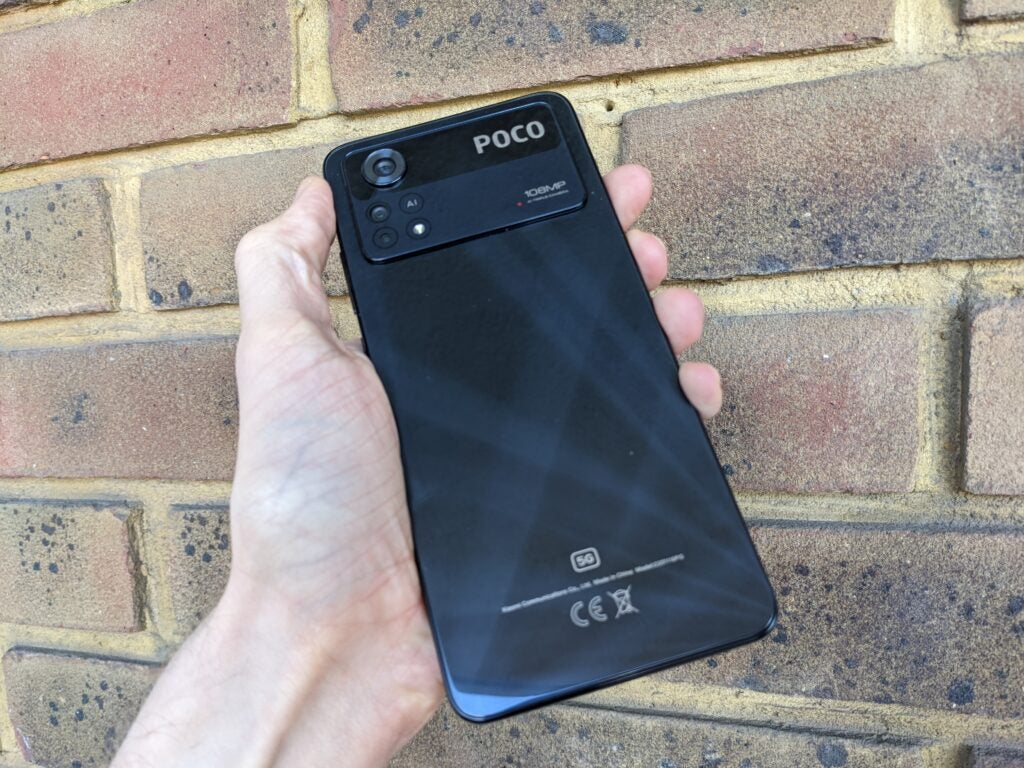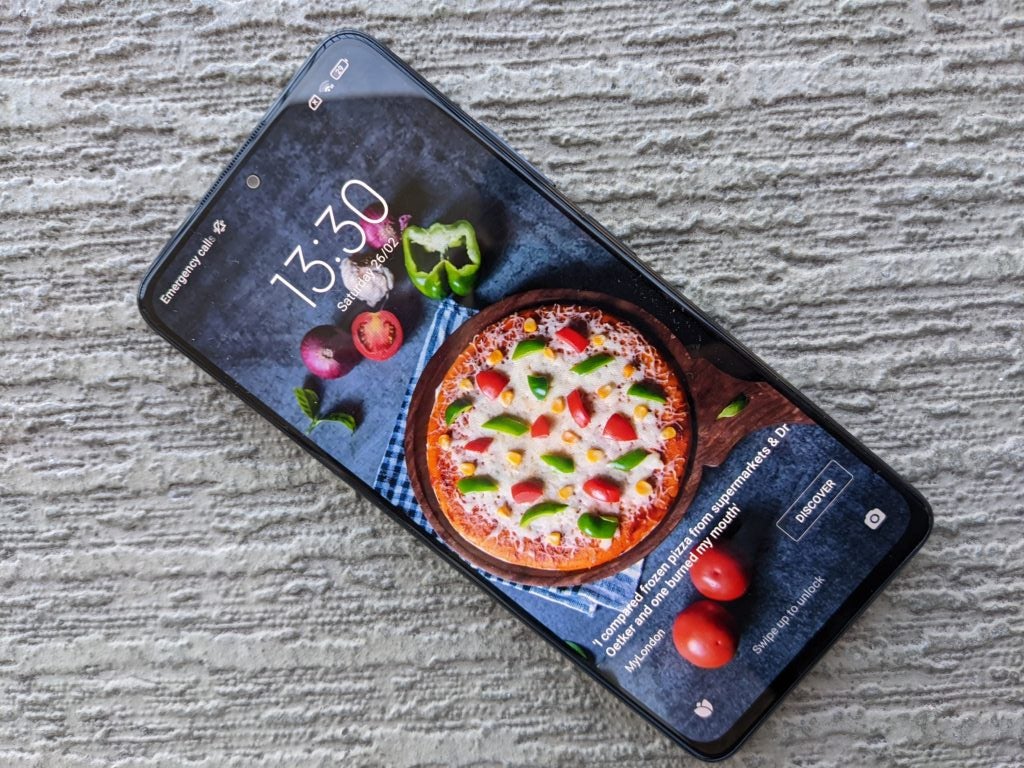Verdict
The Poco X4 Pro is a great value handset that offers a wonderful screen, a very capable camera, and 5G connectivity. The design may not be to everyone’s tastes, but this device is well worth your consideration if you’re on a £260 budget.
Pros
- Great screen
- Very good main camera
- 67W fast-charging
- Strong battery life
Cons
- Unsubtle design
- Not the most powerful processor
- Secondary cameras aren’t brilliant
-
Top-tier screen specificationsThe 6.67-inch AMOLED display has a 120Hz refresh rate, HDR10 support, and 1200 nits peak brightness -
5G connectivityWith a 5G modem, you’ll get access to the fastest mobile data speeds -
108-megapixel main cameraThe camera system is led by a high-resolution sensor -
Affordable priceDespite the eye-catching specifications, you won’t have to shell out a huge amount of your cash to buy this handset
Introduction
Poco is a sub-brand of Xiaomi that specialises in budget phones. In previous years we’ve been particularly impressed by the likes of the Poco F3, but can the Poco X4 Pro improve upon that high standard?
With stand-out specs such as a 108-megapixel main camera, 67W fast-charging, a 5000mAh battery and a 120Hz display refresh rate, things certainly look promising for this well-priced phone.
Design and Screen
- Unattractive looks
- Brilliant screen
- Gorilla Glass 5 and IP53 certification
While the Poco X4 Pro 5G punches above its weight in many respects, the design is one element where it lets itself down quite a bit. The camera module spans most of the device’s rear and is downright ugly, with a huge brand name plastered over it for good measure.

The back panel itself is quite eye-catching, especially when the sun’s out, as then it catches the light with glistening criss-crossing streaks from top to bottom. However, this added gloss actually makes it quite slippery to the touch, and given the large and protruding camera module as well, I unfortunately discovered on a couple of occasions that this does make it a little prone to falling off slightly inclined surfaces if you haven’t set it down carefully.
When you want to unlock the device, you’ve got the choice of using Face Unlock on Fingerprint Unlock (via the scanner that’s embedded in the power switch); in my experience, both of these methods worked reliably and efficiently.
Fortunately, there are some practical touches at play with the design, despite its undoubtedly divisive appearance. The screen is cast in Gorilla Glass 5, meaning that it should be quite resistant to bumps and scratches. It also has an IP53 certification, which means it’s protected from some water spray and from limited dust ingress. The Poco X4 Pro has also got a MicroSD slot for expandable storage in addition to the maximum of 256GB that’s onboard – you won’t find that on a many of the best phones, like the Samsung Galaxy S22 Ultra. There’s a 3.5mm headphone jack too, another feature usually lost on high-end phones now.

The screen will not have nearly as many detractors as the design, since it’s frankly flat-out excellent for the price.
Measuring a generous 6.67-inches diagonally across, this AMOLED panel boasts excellent contrast compared to LCD counterparts, while at 1080p the resolution is plenty sharp enough for watching videos or playing games.
The 120Hz refresh rate is a killer feature for this price, making content such as social media feeds nice and smooth to scroll down due to the screen being constantly updated. It’s worth noting though that unlike premium devices like the OnePlus 10 Pro which can offer adaptive refresh rates, this one can only be set at 120Hz or the standard 60Hz manually, without any ability of automatic adjustment for battery conservation.
I also found the adjective brightness to be responsive and effective, with the panel lighting up quickly enough to ensure that I never had to scrunch my face up to make out what was on my screen, even when under direct sunlight.
Camera
- Strong 108-megapixel main camera sensor
- Secondary sensors and selfie camera aren’t on the same level
One of the headline specs of this device is, without doubt, its 108-megapixel main camera. If the screen specs weren’t enough to get you rubbing your eyes and double-taking the price-tag, then this one will, as habitually I would expect this sensor to be found in much more expensive devices.


Night Mode clears up some of the noise and restores natural colours, as you can see from the picture below. However, clearly this mode is not as impressive as slightly pricier mid-range phones like the Pixel 4a.

You can choose to employ Artificial Intelligence to the photos via the phone’s AI mode, which recognises different scenes and adjusts them accordingly – so for instance it might add colour to a plate of food to make it look more appetising. Generally speaking though, I found that it just added lurid levels of colour to the image without really improving it. If you’ve a fan of the super-saturated look then you might want to use this option, but I preferred the results when it was switched off.

The impressive main camera is accompanied by a 2-megapixel macro sensor, and an 8-megapixel ultrawide lens. The ultrawide lens isn’t particularly impressive, as you can see from the snap above, and the jump down in quality is glaringly noticeable when you switch to it from the main. The loss of detail means that you’ll be best advised to stick to the main camera as much as possible when you’re shooting.

The macro camera is, as per usual on phones of this type, unnecessary and not particularly good quality; I doubt you’d use this very much as it rarely comes in handy.

You’ve not got a dedicated telephoto sensor here, so if you want to get closer to your subject then the best you can do is make use of the digital zoom on the main sensor. Above is an image taken at 2x digital zoom, and as you can see there is an obvious loss of detail even at this extent, but it does still produce usable pictures.
The selfie camera is adequate but not particularly good, with photos generally having a washed-out look that does not deliver much detail.

When it comes to video recording, you can take 1080p footage at 30fps. You can’t record at 60fps, so the video results aren’t all that smooth, and despite the sensor’s high resolution you can’t record in 4K quality either, which is probably down to the limitations of the processor.
Performance
- Decent, but not standout, performance levels
- 5G connectivity
The Poco X4 Pro runs on a mid-range Snapdragon 695 processor, which isn’t the fastest around but fortunately does pack in a 5G modem so that you can have access to the very latest in mobile data speeds.
It’s far from a given for a phone at this price point to have 5G connectivity, so that’s a major selling point in its favour, particularly if you’d like it to be somewhat future-proof. In addition to 5G, the handset also has dual-band Wi-Fi and Bluetooth 5.1 connectivity.
In the table below, you can see how the Poco X4 Pro stacks up when compared to its peers – and while it’s not the best in class, it’s certainly no slouch either. The Geekbench scores refer to the CPU ability, which is the part of the processor that manages most tasks that you undertake, while the 3DMark scores judge its GPU performance, which is a particularly good indicator for its gaming ability.
I never noticed any lag or glitching when using the phone on a daily basis, and what’s more it also performed well when playing mobile games too, although naturally not at the level of a flagship phone.
The software at play here is a “Poco version” of MIUI 13, and it’s based on Android 11. I’m not a great fan of MIUI, which always comes stuffed with bloatware upon installation and even shows adverts at some points – I’d much prefer a cleaner and more streamlined software package. Extra features include the ability to create a separate app drawer that hides away sensitive apps you wouldn’t want other people to see, though this doesn’t add a great deal of added value all in all.
Battery
- Potential two-day battery life
- 67W fast-charging
The battery has a generous 5000mAh capacity, and this is brought to bear with impressive effect. I never came close to draining the battery completely, even after up to six hours of screen-on time in one day. If you use your phone relatively conservatively, I could easily see it lasting you two days.
In terms of specific tasks, I watched an hour of Netflix and the battery drained by 5%, while streaming music on Spotify brought the battery down by just 2% after an hour.
Not only can the battery stand up to intensive usage, but you can top it up again very quickly as well thanks to the 67W charging – and this charger is included in the box too. This is advertised as being able to top you up to 90% from zero in just 31 minutes, which is highly impressive for any smartphone let alone one that costs relatively little.
Should you buy it?
You’ve got a budget of around £250, because the all-round performance of this phone, particularly with regard to the main camera, the screen, and the battery, is very hard to beat for the price.
You want a powerful processor (particularly for gaming) or a more versatile camera system.
Final Thoughts
Bearing in mind the eminently reasonable price tag on this phone, it’s very hard to find much fault with it. The main camera performs very well, the screen is great, the battery lasts long (and can be topped up with speedy fast-charging too), and these elements are all individually difficult to find for this amount of money, let alone all in one phone.
Of course, this device isn’t perfect; I’m not a fan of the loud design, the software is a bit clunky, and the secondary camera sensors aren’t great. But I’d judge these imperfections to be fairly easy to overlook given the otherwise brilliant performance of the Poco X4 Pro, even when you compare it to good-value rivals like the OnePlus Nord N10 5G and the Realme 8 Pro.
FAQs
Yes, you can make use of 5G data provided you have a compatible SIM card and network coverage
There are three possible colours: Laser Black, Laser Blue, and Poco Yellow
Yes
Jargon buster
mAh
An abbreviation for milliampere-hour and a way to express the capacity of batteries, especially smaller ones in phones. In most cases the higher the mAh, the longer the battery will last but this isn’t always the case.
5G
Offering faster download and upload speeds when compared to 4G. Great for game streaming and HDR video playback. Not supported everywhere yet and speeds vary wildly.
IP rating
An abbreviation for ‘Ingress Protection Code’, which lets you know to what extent a device might be waterproof or dustproof.
OLED and AMOLED
Types of displays that use self-lighting pixels to provide greater contrast and more vibrant colours than a typical LCD display, as well as sharper blacks.
















